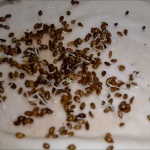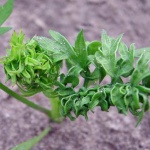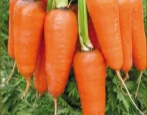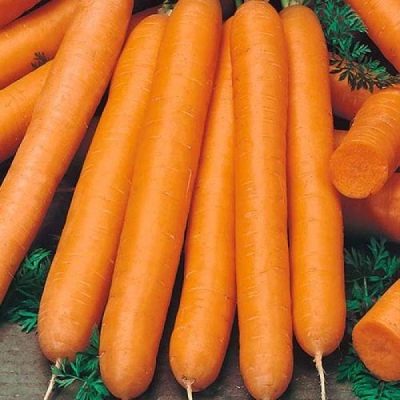
- Name synonyms: Amsterdamska
- Year of approval: 1998
- Appointment: for fresh consumption, for bundled products, for making juice
- Leaf rosette shape: semi-spreading
- Leaves: short, green, strongly split
- Weight, g: 53-154
- The form : cylindrical, blunt tip
- Taste qualities: good ones
- Ripening terms: early
- Growing regions: TsCHO
Amsterdam carrots are rarely included in the ratings of the best varieties. The selection of the very best filled hybrids. But varieties also have merits.
Description of the variety
Amsterdam carrots are early, tasty carrots, very productive, active. It is hardy and does not tend to bloom even in the wrong conditions. Fruits are even, do not crack. The variety was bred in Poland; it was included in the Russian State Register in 1998.
Amsterdam is a cultivar, so you can try to get your own seeds.
Characteristics of the appearance of the plant and root crops
The rosette of leaves is low, up to 50 cm, medium spreading. The foliage is openwork.
Root crops are cylindrical in shape, with rounded shoulders and a rounded tip. Very even, slender, tapering slightly towards the end. Length - 14 to 16 cm, diameter 3-4 cm. Fruits look beautiful, with a good balance of length and width. Average weight - 53-154 grams. The fruits are even, perfectly calibrated. The shoulders may protrude slightly above the soil. The heart and bark are bright orange, very juicy.
Purpose and taste of tubers
The taste is very good. The pulp is crispy, tender, very sweet. Carrots do not tend to turn green and bitter. The variety is grown for fresh consumption and for sale in bunches. Root vegetables in bundles look impressive and presentable. Suitable for making juices.
Maturation
The variety is early ripe, you can get carrots to the table within 80 days after the emergence of mass shoots.
Yield
The yield is excellent, the carrots are capable of producing more than the standard varieties of Nantes 4 or Vitamin 6. From 1 hectare, an average of 208 to 463 centners of carrots are removed, from 1 sq. m - 4.6-6.7 kg.
The yield of marketable products varies depending on the growing conditions, it can range from 66% to 96%. It is difficult to say how good this indicator is, because the standard varieties show a lower maximum indicator, but the range is also smaller - from 73 to 85%. That is, Amsterdam carrots are less stable, but they have excellent potential.
Growing regions
Carrots are officially recommended for cultivation in the Central Black Earth Region, it is here that its agricultural technology will be the simplest. But the variety is successfully grown in other regions of the Russian Federation.
Growing and care
The variety is intended for private household plots and small-scale farming. According to your needs, this is a classic carrot.
Seeds are sown to a depth of no more than 2 cm, the exact depth depends on the type of soil. In denser soils, the seeds are buried no more than 0.5 cm.
The distance between the specimens is 5-7 cm, between the lines - at least 15 cm. It is very useful to alternate rows of carrots with onions - the latter protects the culture from diseases.
With thickened plantings, they thin out several times per season, removing the weakest shoots.
Loves abundant and even watering. Amsterdam carrots are not prone to cracking, but even the most resistant variety will begin to crack if heavy rains are followed by periods of drought.
After watering, the soil is loosened, too dense soil can lead to the formation of roots on the surface of the root crop - there is a risk of digging out "shaggy" carrots in the fall. Mulching is very useful, especially if it is not possible to organize drip irrigation or regularly monitor the moisture of the garden. Mulch with dry peat, straw or grass.
It is not recommended to apply fresh manure under the carrots, the tops will begin to grow intensively, and the root crops will become crooked and branched.
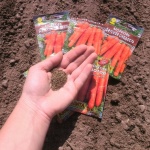
Carrots are one of the most unpretentious crops in terms of growing conditions; they can endure a short drought and a short cold snap. However, to get tasty and large root crops, you should adhere to the basic rules for planting carrots.


Soil requirements
The best soil for carrots is loose and fertile loam or sandy loam. Fresh manure is not applied for carrots, only well-rotted, 2-3 years old. The soil must be well-drained. The beauty and taste of the crop depend on the softness and nutritional value of the soil.
Required climatic conditions
Cold resistant. Seeds begin to germinate already at a temperature of + 3 ... 6 ° C. Optimum temperatures for growing carrots are + 20 ... 22 ° С. Seeds can be sown before winter. The planting site should be sunny, without dampness.
Disease and pest resistance
The variety, according to the originator, has medium resistance to Alternaria. According to the observations of gardeners, it is quite resistant to carrot fly. There are no varieties completely immune to carrot fly, but Amsterdam has good general immunity. Subject to preventive measures (following the rules of crop rotation, planting next to onions and garlic, planting in a sunny area, well-drained soil, not thickened plantings), the carrot fly does not appear on the plantings of the variety.

Carrots grow in almost any garden. There is an opinion that this culture is very resistant to all kinds of diseases and pests, but this is not the case. Without proper care, carrots become susceptible to all kinds of infections and are affected by harmful insects.
Review overview
The reviews are positive. Amsterdam is a beautiful showy variety. Fresh seeds are active, their united growth makes a strong impression. There are claims to the caliber, carrots may not be as smooth and the same as other modern varieties. But then there are reviews where the root crops are ideal - one to one. High productivity and endurance are confirmed by all. The taste is excellent, very juicy, sweet, with smooth, smooth, pleasant pulp.
During winter storage, it may become slightly fibrous and lose sweetness. But on average it is stored very well for such juicy and early carrots. Ideal for fresh food and juices. Suitable for everyone looking for an early maturing universal variety.


